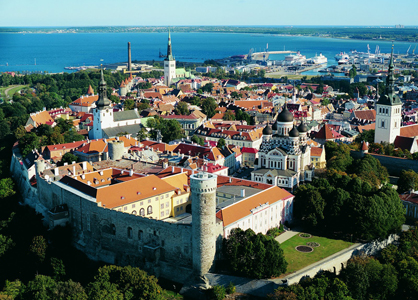The new markets have come along way since freeing themselves from oppression. But many still have more to do.
The new markets have come along way since freeing themselves from oppression. But many still have more to do.
Only 20 years ago, Baltic states were covered by the monolithic Iron Curtain of Soviet rule. It’s hard to believe that now, especially when visiting the countries - the main cities anyway - and it’s impressive to see how far they have come in terms of infrastructure and commerce. Estonia, for example, has one of the best broadband infrastructures in the world.
But, as with any country or institution that attempts huge changes in a short space of time, there are issues arising. In some regions, the liquidity of the markets remain low, while in others the regulatory infrastructure still has some way to go before it meets the standards of the developed world.
And there remains the issue of understanding - those who grew up under communist rule had no need to worry about saving for their future, or investing their incomes, and that has led to the younger generation taking control.
The key challenge that remains for the securities lending market, especially in some of the smaller markets, is the limited numbers of stocks available for lending. Some of the exchanges have liquid stocks only in the dozens, leaving little room for manouvre.
But one of the key benefits of working in Eastern Europe is that because everything is so new, there are few legacy issues that affect the market. Most countries looked at models that already worked when designing their markets, so most Western investors and providers will be familiar with the technology, infrastructure and regulatory regime from markets in Germany, the UK and elsewhere.
As most of the most popular Eastern European jurisdictions are also part of the European Union, they are involved in the creation of the new pan-European legislation that will impact the financial services industry. This is expected to help the smaller states, as an increasingly harmonised regulatory regime will, they hope, encourage greater investment into their markets by firms familiar with the rules.
Estonia has become one of the most technologically advanced European states and has a reputation for welcoming international firms to Tallinn. It’s also the newest eurozone country, changing currency at the start of the year. It originally planned to adopt the euro on 1 January 2007; however, it did not formally apply when Slovenia did, and officially changed its target date to 1 January 2008, and later, to 1 January 2011. On 12 May 2010 the European Commission announced that Estonia had met all criteria to join the eurozone. On 8 June 2010, the EU finance ministers agreed that Estonia would be able to join the euro on 1 January 2011. On 13 July 2010, Estonia received the final approval from the ECOFIN to adopt the euro as from 1 January 2011.
This has extended the country’s advantage over its neighbours. Since the fall of communism, Estonia has been at the forefront of changing its infrastructure to welcome international business, as well as nurture its own industry. Moving from an industrial base, the country is now one of the leading technology centres, with strong IT capabilities and a burgeoning medical science sector.
When it comes to regulation, Estonia has learned from its more mature neighbours and built a structure that provides reassurance to both local and international players.
The Central Bank of Estonia is independent from all government agencies and directly responsible to the parliament. The BoE is primarily responsible for setting out Estonia’s monetary policy framework. The BoE is also responsible for maintaining financial stability in Estonia. In this respect, the BoE in cooperation with the Ministry of Finance and the Financial Supervision Authority, is responsible for preparing regulations affecting the Estonian financial sector. In addition, the BoE operates the Estonian interbank payment system. Next to its core tasks, the BoE has been mandated to prepare Estonia’s accession to the European Monetary Union and the adoption of the euro, the European single currency.
The Financial Supervisory Authority is an independent agency with autonomous competence, it conducts financial supervision in the name of the state. FSA analyses and monitors the compliance of subjects of financial supervision with the requirements for financial soundness and own funds, and other obligations prescribed by the Bank of Estonia; makes proposals for the establishment and amendment of Acts and other legislation concerning the financial sector and related supervision, and participate in the drafting of such Acts and legislation; performs the functions arising from the Guarantee Fund Act and the Money Laundering and Terrorist Financing Prevention Act; performs other functions arising from law which are necessary to fulfil the objectives of financial supervision. NASDAQ OMX Tallinn and the FSA co-operate in the course of exercising market supervision.
Meanwhile, the Ministry of Finance is responsible for issuing regulatory acts implementing the laws and controlling market procedures. The main functions of the Ministry of Finance of Estonia are to plan and supervise the implementation of the Government’s macroeconomic, fiscal and economic reform policies. This is carried out by preparing legislation, planning state revenues and expenditures, managing and supervising the state budgetary spending process and preparing a framework for economic policy and development.
Securities lending is a small part of its market, simply because there are few local firms that hold interest to international investors, but there is certainly activity in the top 10-15 stocks.
There’s no formal securities lending regulation within the Estonian regulatory infrastructure, although short selling is not permitted. Securities lending is allowed, but it’s only offered on the OTC market. Local custodians do sometimes practice buy and sellback transactions externally but the market has some way to go before securities lending becomes a common practice. The introduction of the euro as the country’s currency at the start of the year, may provide some stimulus. The Tallinn Stock Exchange (TSE) is now part of the OMX Group, which means Nordic investors are well-represented.
The TSE forms part of the NOREX Alliance, a co-operation between independent exchanges, based on the following principles:
use of INET/SAXESS as the joint trading system. INET for cash, equities (shares and fund units) and SAXESS for fixed income securities (bonds)
cross-membership
common regulatory framework (eg harmonised trading hours and membership requirements)
a single point of liquidity, i.e. companies are encouraged to list their securities on only one NOREX Exchange.
Estonia’s only problem when it comes to encouraging a financial market is its size. There simply aren’t enough stocks to encourage significant investor interest, or the requirement for firms to invest heavily in their own infrastructure in the region and then leverage that infrastructure into building up the market. The connectivity with the OMX Group means that it is more attractive than it maybe would be otherwise, but the country does still need to grow before it becomes a major player.
Neighbouring Latvia, while structurally sound, has a much smaller market, and securities lending is virtually non-existent. Short selling isn’t permitted, but foreign investors are welcome.
Lithuania, which makes up the trio of Baltic states is in a similar position, although securities lending transactions are slightly more common. It’s still only offered on the OTC market, and custodians can provide lending transactions on a case-by-case basis for more regularly traded securities.
So while Estonia is leading the way, securities lending remains in its infancy within the Baltic states. The market at the moment is simply too small, and it really needs to grow to attract significant investor interest.
Because the three countries are so commonly referred to as the Baltic market, it’s possible that closer co-operation between the trio will give them the scale to increase their attractiveness. But they have the basis right, and should prove a good long term bet.


